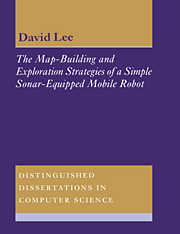 The Map-Building and Exploration Strategies of a Simple Sonar-Equipped Mobile Robot
The Map-Building and Exploration Strategies of a Simple Sonar-Equipped Mobile Robot Published online by Cambridge University Press: 05 March 2012
This chapter summarises the results of the experiments that were reported in Part III of this thesis.
Section 18.1 examines the performance of the sensor model by analysing the results of the wall-following explorations that were presented in Chapter 13. Section 18.2 uses the same experimental data to consider the effectiveness of the feature-based map-building algorithm.
Chapters 12 to 17 described a variety of exploration strategies and presented the results of experiments to evaluate those strategies. Section 18.3 collects those experimental results together in order to compare all of the autonomous strategies across the set of test environments.
Section 6.3 introduced a sensor model in which adjacent sonar returns of similar range were grouped into ‘readings’ to decrease the uncertainty caused by the width and uneven strength of the sonar beam. Table 18.1 shows the number of readings of each size that were taken during the wall-following explorations of the three main test environments. It can be seen that approximately 20% of the readings contained two or more returns. Expressed in terms of the raw returns instead of the readings, the results show that 37.5% of the returns were included into groups of size two or more. (Maximum-range returns are excluded from the grouping process and from this calculation.) This supports the opportunistic nature of this approach, grouping the returns where possible but using all of the available information. An insistence that groups contain at least two returns would have eliminated almost two-thirds of the returns.
To save this book to your Kindle, first ensure [email protected] is added to your Approved Personal Document E-mail List under your Personal Document Settings on the Manage Your Content and Devices page of your Amazon account. Then enter the ‘name’ part of your Kindle email address below. Find out more about saving to your Kindle.
Note you can select to save to either the @free.kindle.com or @kindle.com variations. ‘@free.kindle.com’ emails are free but can only be saved to your device when it is connected to wi-fi. ‘@kindle.com’ emails can be delivered even when you are not connected to wi-fi, but note that service fees apply.
Find out more about the Kindle Personal Document Service.
To save content items to your account, please confirm that you agree to abide by our usage policies. If this is the first time you use this feature, you will be asked to authorise Cambridge Core to connect with your account. Find out more about saving content to Dropbox.
To save content items to your account, please confirm that you agree to abide by our usage policies. If this is the first time you use this feature, you will be asked to authorise Cambridge Core to connect with your account. Find out more about saving content to Google Drive.